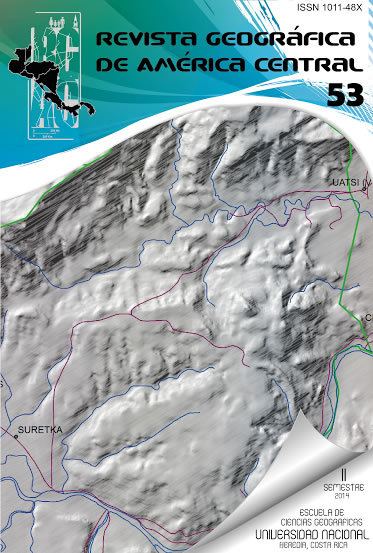TREATMENT SERVICES FOR DRUG PROBLEMS. CHARACTERISTICS OF SUPPLY AND TERRITORIAL ACCESSIBILITY IN COSTA RICA
DOI:
https://doi.org/10.15359/rgac.2-53.6Keywords:
Accessibility, Drug, Treatment Services, Geographical Information System, Costa RicaAbstract
In Costa Rica, the problem of drug use has required geographical studies to determine the health needs of the population in various locations. In this regard, the Institute on Alcoholism and Drug Dependence has been developing a strategy of geolocation and analysis of the availability of treatment services. This article shows the characteristics of the distribution of resources available to care for people with drug problems, analysis of the supply of treatment services and type of care. Using Geographic Information System (GIS), geo-referencing was achieved to differentiate the supply and type of services available in various regions. The study revealed a territorial inequity in the distribution of resources, with the highest concentration of drug treatment centers located in the central region of the country and more services for men than women. The study illustrated the importance of seeking more equitable alternatives for the population and further research in the field of drug use and health.
References
Bosque, J. & García, R. (2000). El uso de los sistemas de información geográfica en la planificación territorial. Anales de Geografía de la Universidad Complutense,20(2), 49-67. Recuperado de: http://revistas.ucm.es/ghi/02119803/articulos/AGUC0000110049A.PDF
Bosoa, G. & Otero, A. (1994). Accesibilidad Geográfica a los Centros de Salud y Planteamiento Urbanístico en Fuenlabrada. Revista de Sanidad e Higiene Pública, 68, 503-511. Recuperado de:
Celemín, J. Ares, S. y Aveni, S. (2010). Utilización de la Evaluación Multicriterio para la localización de Equipamiento Sanitario: Aplicación a la Ciudad de Mar del Plata. Revista digital del Grupo de Estudios sobre Geografía y Análisis Espacial con Sistemas de Información Geográfica, 2, 1-19. Recuperado de:www.gesig-proeg.com.ar/documentos/.../CELEMIN-ARES-AVENI.pdf
Claval, P. (1979). La nueva geografía. Barcelona, España: Oikos-tau S.A.
Cuervo, M. & Morales, F. (2009). Las teorías del desarrollo y las desigualdades regionales: una revisión bibliográfica. Análisis económico, 55, 366-383. Recuperado de: http://www.analisiseconomico.com.mx/pdf/5517.pdf
Curto, I. (2008). De la Geografía Médica a la Geografía de la Salud. Revista Geográfica del Instituto Panamericano de Geografía e Historia, 143, 9-29. Recuperado de: http://www.ipgh.org/Publicaciones/Files/Periodicas/RGE/RGE-143.pdf.
Escalona, A. & Díez, C. (2003). Accesibilidad geográfica de la población rural a los servicios básicos de salud: Estudio en la Provincia de Teruel. Revista de Estudios sobre Despoblación y Desarrollo Rural, 3, 111-149.
Fuenzalida, M. (2011). Diseño de esquemas de localización óptima para hospitales del servicio de salud Viña del Mar-Quillota (Chile) discriminando según status socio-económico. GeoFocus, 11, 409-430. Recuperado de: http://www.inegi.org.mx/eventos/2011/Conf_Ibero/doc/ET3_20_FUENZALIDA.pdf.
Hernández, M; Iñiguez, W; Rojas, L. Gerhartz, A (2014). Acercamiento Geográfico al Sistema de Salud de la Provincia de Pinar del Río. Novedades en Población 1817-4078 (2012) 8(15), 1 – 15. Universidad de La Habana. La Habana.
Instituto sobre Alcoholismo y Farmacodependencia (2011). Estimación de la demanda de tratamiento de personas menores de edad consumidoras problemáticas de sustancias psicoactivas en Costa Rica 2011. Proceso de Investigación. San José, Costa Rica: IAFA, 2013.
Instituto sobre Alcoholismo y Farmacodependencia (2013). Directorio: Programas de prevención, tratamiento y rehabilitación de problemas asociados al consumo de sustancias psicoactivas. San José, Costa Rica.
Ramírez, M. (2009). La moderna geografía de la salud y las tecnologías de la información Geográfica. Revista investigaciones y ensayos geográficos, 4, 53-64, recuperado de: http://hum.unne.edu.ar/investigacion/geografia/labtig/publicaciones/public17.pdf
Ramírez, L. & Bosque, J. (2001). Localización de hospitales: analogías y diferencias del uso del modelo P- rnediano en Sig raster y vectorial. Anales de Geografía de la Universidad Complutense, 21, 53. Recuperado de http://revistas.ucm.es/ghi/02119803/articulos/AGUC0101110053A.PDF.
Villanueva, A (2010). Accesibilidad geográfica a los sistemas de salud y educación. Análisis espacial de las localidades de Necochea y Quequén. Revista Transporte y Territorio, 2(2), 136-157.
Downloads
Published
How to Cite
Issue
Section
License
Proposed policy for journals offering Open Access
Authors publishing their works in the Journal acknowledge and agree to the following terms:
a) Authors retain the copyrights to their works and guarantee the Journal the right to be the first to publish their works, under the Creative Commons License Attribution-NonCommercial-ShareAlike 4.0 International, CC BY-NC-SA 4.0 International (https://creativecommons.org/licenses/by-nc-sa/4.0/deed.es), which allows others to share works upon complying with the acknowledgment of authorship and mention of the Journal as the original publisher of the work.
b) Authors are permitted to separately establish additional agreements for the non-exclusive distribution of the official edition of the work published in the Journal (for example, authors may desire to place the work in an institutional repository or incorporate it into a book that is to published elsewhere) so long they acknowledgment to recognize the Journal as the original publisher. The aforementioned additional agreements must respect the terms of the non-profit character and sharing philosophy of the original license (CC BY-NC-SA 4.0 International, https://creativecommons.org/licenses/by-nc-sa/4.0/deed.es).
c) Authors are encouraged to archive the post-print or editor/PDF version in Open Access repositories.






 REVGEO is licensed under https://creativecommons.org/licenses/by-nc-sa/4.0/deed.es
REVGEO is licensed under https://creativecommons.org/licenses/by-nc-sa/4.0/deed.es
.svg_4.png)

_(1).png)
_(1)_(1)_(1)_1.png)
(2)(1)(1)(1).png)
